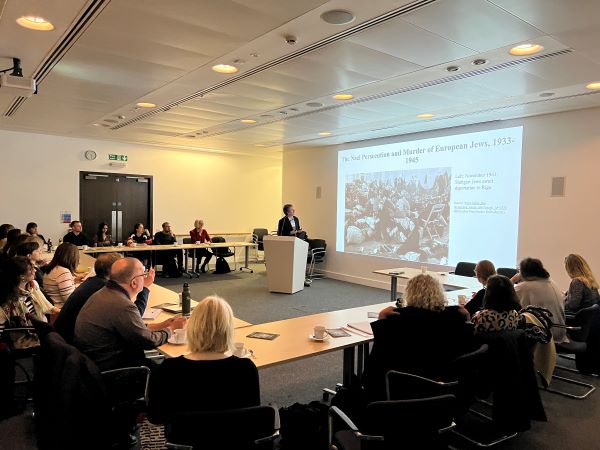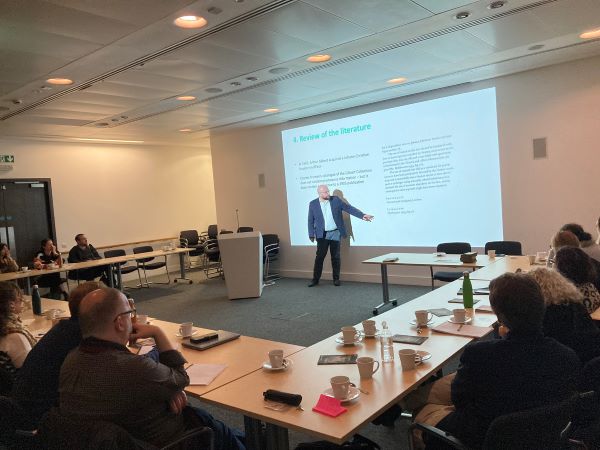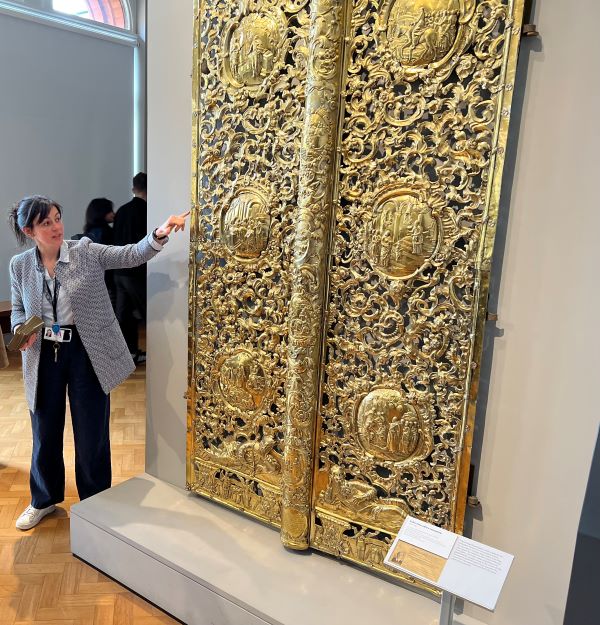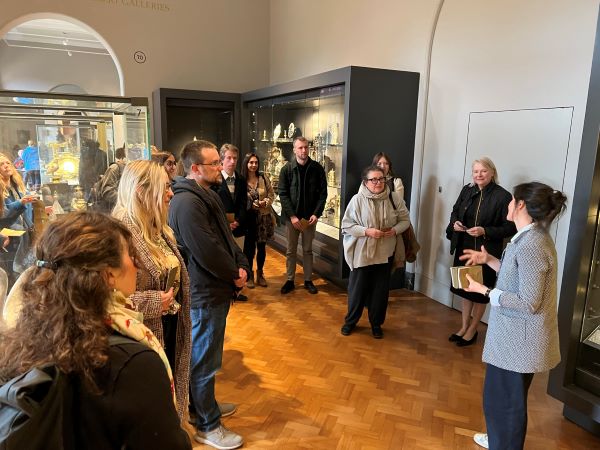News:
Report on the Spoliation Working Group's Provenance Research Training at the Victoria & Albert Museum April 2023
Introduction
When we look at the works of art on display in Britain’s museums, there is always a possibility that some of these objects once belonged to victims of the Nazi regime. This troubling legacy has often remained unexplored and unacknowledged for far too long. This is surprising in itself: these very same museums were acutely aware of Nazi looting across Europe, and many of them played an important role in the post-war restitution effort; some even counted former ‘Monuments Men’ among their curators after the war. Yet, from 1945 onwards, these institutions usually did not ask in-depth questions about the provenance of the items that they were adding to their collections. This practice only changed in 1998, more than 50 years after war’s end, with the landmark Washington Conference on Holocaust-Era Assets, which brought unprecedented awareness to the material legacies of the Nazi past in museum collections. Crucially, it emphasised that this was not just an issue for museums in Germany and the countries formerly occupied by the Nazis, but also potentially affected any museum in the world. In this context, the Victoria &Albert Museum’s former director, Alan Borg, who was also at the time the Chairman of the National Museum Directors’ Council, placed this issue high on the agenda of Britain’s museums. NMDC issued a ‘Statement of Principles and Proposed Actions’, which condemned the Nazis’ radical campaign of persecution and dispossession and also committed museums to researching the Nazi-era provenance of their existing collections. Furthermore, it required museums to ask the same questions of potential acquisitions and incoming loans.
The task was vast and continues to this day, bringing its own unique challenges that often take art museum professionals beyond their disciplinary comfort zones. To support these professionals to carry out this important, difficult and time-consuming work, Dr Jacques Schuhmacher (Senior Provenance Research Curator supported by The Polonsky Foundation, V&A) and Dr Susanna Avery-Quash (Jacob Rothschild Interim Head of Curatorial, National Gallery) of the NMDC Spoliation Working Group organised a full-day Nazi-era provenance workshop on 27 April 2023 at the V&A. The first of its kind, this workshop brought together 30 curators, librarians, registrars and collections managers working on a wide range of collections across the spectrum of UK museums, representing institutions from Portsmouth to Hartlepool, London to Glasgow. The composition of the group made clear that the issues at hand touch every kind of collection, from national to regional and university holdings.
Historical Foundations: The Nazi Persecution and Murder of European Jews, 1933-1945
The first part of the workshop provided the vital historical background and policy context, an understanding of which is essential to contextualise this important work. Dr Thomas Brodie, Director of the Institute for German and European Studies and Lecturer for 20th-Century European History at the University of Birmingham, gave a lucid and often moving overview concerning ‘The Nazi Persecution and Murder of European Jews, 1933-1945’. As Dr Brodie made clear, at the core of the Nazi movement’s worldview was its hatred of the Jews. Once installed in the corridors of power, they mobilised the might of the German state to torment the Jewish community. The regime issued a series of escalating decrees, accompanied by waves of violence, designed to exclude Jews from public life and the economy, forcing them into a state of isolation and despair. As the social, economic and legal pressures continued to build, many Jews were left with no choice but to part with their possessions, hoping either to raise funds in order to survive in this hostile environment, or to finance their escape from Hitler’s regime. As the Reich aggressively expanded across the European continent, the Nazis exported their ideology and its mechanisms of persecution and dispossession, all of which were further radicalised in the violent environment of war. This would ultimately lead to the systematic mass murder of millions of innocent Jewish men, women and children. Dr Brodie shed light for us on this vast and complex campaign, whose terrible mission is encapsulated in the words of a Holocaust survivor: ‘Slaughter the Jews and take their property’. Among the myriad items confiscated were countless works of art.

Post-War Realities: From the Monuments Men to the 1998 Washington Conference and beyond
Following this insightful historical overview, Dr Jacques Schuhmacher (V&A) turned the spotlight onto Britain’s museums. Even before the Nazi regime was defeated, curators and art historians in the service of the Allies gathered huge amounts of information concerning Nazi looting. Their goal was to recover and return the vast number of looted works of art to the galleries and private collections from which they had been taken. In the ruins of the Third Reich, curators and others catalogued objects and painstakingly attempted to establish where each one had come from, resulting in the restitution of millions of items. While this was a truly remarkable effort, museum collections were not subjected to the same scrutiny as the treasures recovered from Nazi institutions. This unexamined legacy continued to grow until the 1998 Washington Conference unexpectedly catapulted the issue back to the forefront of the art world. The Washington Principles on Nazi-confiscated Art galvanised research into Nazi-era provenance across the museum world. Dr Schuhmacher highlighted the favourable environment for this important research in the UK. In contrast to many other countries, the British museum sector recognised the moral urgency of the task and made an unequivocal commitment to this work, resulting in the NMDC Statement and the creation of the Spoliation Working Group, which coordinates the efforts of UK museums in this area. Furthermore, NMDC created the Advisory Group on Spoliation Matters, a group of experts who provide specialist advice to museums.
The work of these bodies is further assisted by the fact that the UK is among a small number of countries to set up an independent restitution committee in the form of the UK Spoliation Advisory Panel, which makes the ultimate decision about the fate of objects carrying a problematic provenance.

Tackling the Nazi-era Provenance of Museum Collections: Research Strategies and Resources
In the second part of the workshop, Dr Schuhmacher and Dr Avery-Quash shared strategies for undertaking this crucial research. Researching the Nazi-era provenance of a museum collection can initially feel daunting and intimidating, not least because of the number of objects involved, their diversity and complex histories. It may also be disorientating to realise that there is not always an obvious place to start. Schuhmacher highlighted that, for example, Jewish collectors naturally appreciated every type of art, ranging from Christian icons to East Asian vessels, modernist paintings to archaeological pieces and classical masterworks. This means that we should never exclude objects from investigation on the grounds of who made them or their place of origin. To do so would be to underestimate the agency and interests of Jewish collectors, and the dynamic flows of the networks of collecting and the reach of the international art market in the first half of the twentieth century. Another common misconception is the fact that the fall of the Third Reich marks a clear cut-off point for our investigations. Instead, we should remember that many relevant objects entered museum collections decades after the war, right up to the present day. Schuhmacher highlighted the limitation of British museum records, which often contain only the name of the owner who gave the object to the museum, in which case they provide merely the starting point for this research. The main challenge is that there is no consolidated list of all the works of art which the Nazis confiscated or extorted from their victims, against which a list of museum objects could be compared. Schuhmacher explained how to use online databases which now allow provenance researchers potentially to sidestep years of fruitless searching in archival holdings, and to connect the objects to a past that is not immediately obvious from the museums’ own records. Using case studies from museums in Britain and Europe, Schuhmacher outlined the research strategies that can be deployed to fill the gaps in an object’s provenance and to discover its full history. During the discussion of how the participants might approach researching their own collections, Avery-Quash emphasised that it is always important to be mindful of the work done by provenance researchers on the continent, which is discoverable through Proveana and the Central Registry for Information on Looted Cultural Property 1933-45, which is arguably the best starting point and research resource for English-speaking provenance researchers.
Bringing Provenance Research into the Galleries
The day concluded with a discussion on how museums are beginning to share this research with a broader publics who are increasingly interested in learning the unvarnished, full and complicated provenance histories of the items on display. Alice Minter, Senior Curator at the V&A, gave a tour of the Gilbert Galleries at the museum and shared the curatorial considerations behind its pioneering special provenance display, ‘Concealed Histories: Uncovering the Story of Nazi Looting’. Attendees were able to examine key items in the display and the provenance stories behind them that the team at the V&A had uncovered using the research techniques described throughout the workshop. Minter emphasised the importance of embedding these objects and their Nazi-era narratives into existing public displays in order to contextualise them properly, and to ensure that vital and intriguing provenance research could reach traditional and new audiences alike.


It is pleasing to note that the workshop was met with much interest and that many participants told us they had gained a better understanding of the issues at stake as well as of the tools necessary to embark purposefully on this vital research. We hope to build on this initiative through offering further training events in different parts of the UK.


